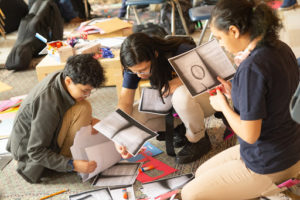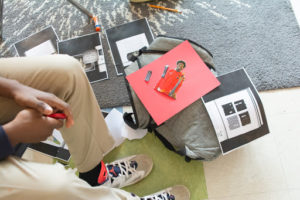The nearly 200 young string players in Grades 3-8 face a challenge: keeping track of their work. They gather the repertoire and notes they are working on in binders, which helps, but it is difficult to find their own binder in a stack of 200. In order to make it easier for young musicians to find their binders, Resident Artists set aside time for students to create a cover that illustrates each of their unique artistic identities.
While personalizing the binders solves a practical problem, its main purpose is to provide an opportunity for each student to investigate their artistic identity, which is a primary goal for social-emotional development in the El Sistema music program.
Many music programs focus on technical ability, but in the El Sistema string orchestra program at Conservatory Lab, Resident Artists believe in the power of music to contribute to students’ self-knowledge. Throughout the year, Resident Artists encourage students to explore how they contribute to the orchestra, including connecting the music they are playing to social narratives from the era when it was created, asking students to consider how their individual skills and expressions contribute to the ensemble, and to taking time to reflect on who they are as artists.
Resident Artists Brad Barrett and Carlos Sulbaran set up the binder project to make space for students to explore how the visual and the verbal relate to their identities as musicians. They share inspiration images with students from two artists, Kehinde Wiley, and Josef Albers, both of whom have work on display at the Museum of Fine Arts. Students then create collages that tell their story, taking ownership of what it means to be a musician as well as their artistic expression.
As we mentioned on the blog in February of 2020, Kehinde Wiley is the artist who painted the official portrait of President Barack Obama. For the portraiture component of the project, Resident Artists took inspiration from Wiley’s juxtaposition of urban identity and glory to inform their process as they photographed students. As Barrett explains, “Wiley describes his work as ‘applying the visual vocabulary and conventions of glorification… [to] subject matter drawn from the urban fabric.’ The people shown in the portraits represent contemporary black culture whom Wiley juxtaposes with styles and poses traditionally reserved for kings and conquerors, questioning stereotypes about race, and disrupting power structures.”
For the portraiture component of the project, Resident Artists took inspiration from Wiley’s juxtaposition of urban identity and glory to inform their process as they photograph students. Sulbaran took snapshots of every young musician, listening to their ideas and encouraging them to pose in a way that illustrated their identity. Some students wanted to look like professionals, some raised their instrument in a celebratory gesture, others hide behind the curve of a violin.
The second artist, Josef Albers, was a Bauhaus Artist known for his avant-garde approach to color and abstraction who engaged the audience instead of just informing the viewer of what was meant to be seen. For the background component of the binder cover, Resident Artists adopted Albers’ bright colors and experimental philosophy. Students were encouraged to think not just about their favorite color, but how the color can express some part of their identity. The abstract shapes inspired by Albers are simpler than the ornate patterns used by Wiley, offering new analytical tools to students as they think about their artistic practice that fit within the time constraints of a single class period.
The textual component of the Binder Cover project, and arguably, the secret sauce which makes it so special, is that Resident Artists also choose inspiration materials from readings they do with students throughout the program. Adopting a 1990’s revolutionary-retro zine-style, they photocopy inspirational quotes, images, and symbols to cut and paste from Zen Guitar (Phillip Toshio Sudo), Creative Quest (by Questlove), Considering the Spiritual in Art, (Kandinsky), Lecture on Nothing (John Cage), and Steal Like an Artist (Austin Cleon). Some students polish it all off by writing or drawing designs and symbols that are important to them in black sharpie.
Barrett shared some things students said about the project in 2018. A seventh-grader said, “I feel like without me saying who I am people could mistake me for so many things- oh you’re mean, you’re nice, you’re talkative- I was just like, let me put what I think I am on my binder cover and see if people get me for who I really am…[maybe it] could like make people think what they said is probably wrong about me.”
Another student who portrayed himself that year as if he were growing out of his bass reflected, “I’m trying to get better. A plant is growing or trying to get taller or grow more leaves so it can get more sun, like the trees. I’m kind of like that because I want to grow more every day.”
Now, in March 2020, Students in Grades 7 & 8 have done this project three times since resident artists introduced it. When asked if they feel like it changes every year, one student expressed, “I like to pick quotes that fit my personality and humor. I like to be able to show who I am as a musician.” Another student held up her binder, and said, “That’s me, right there! I don’t hold back.”
When it’s all done, students have taken time to reflect on who they are and how they’ve changed as musicians. Binder images from past years line the bulletin boards next to the orchestra rooms, creating a place where their choices shine through and celebrating how Conservatory Lab’s young musicians have grown.




